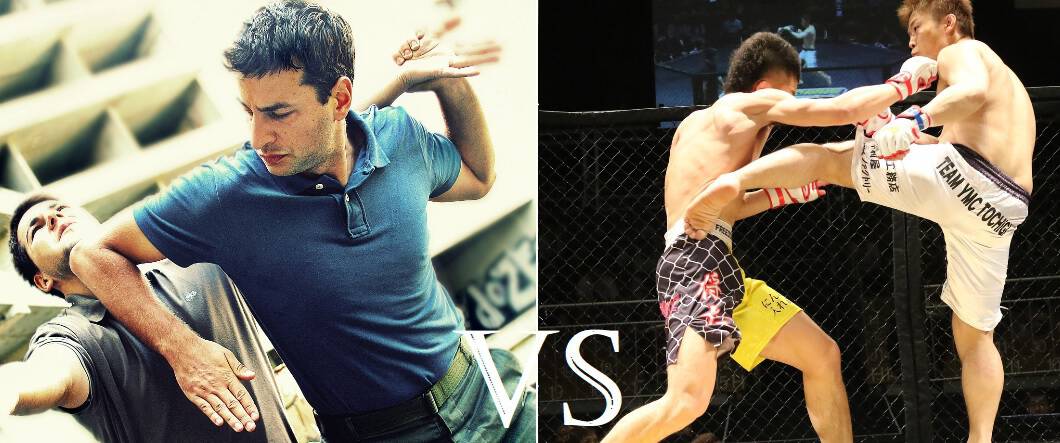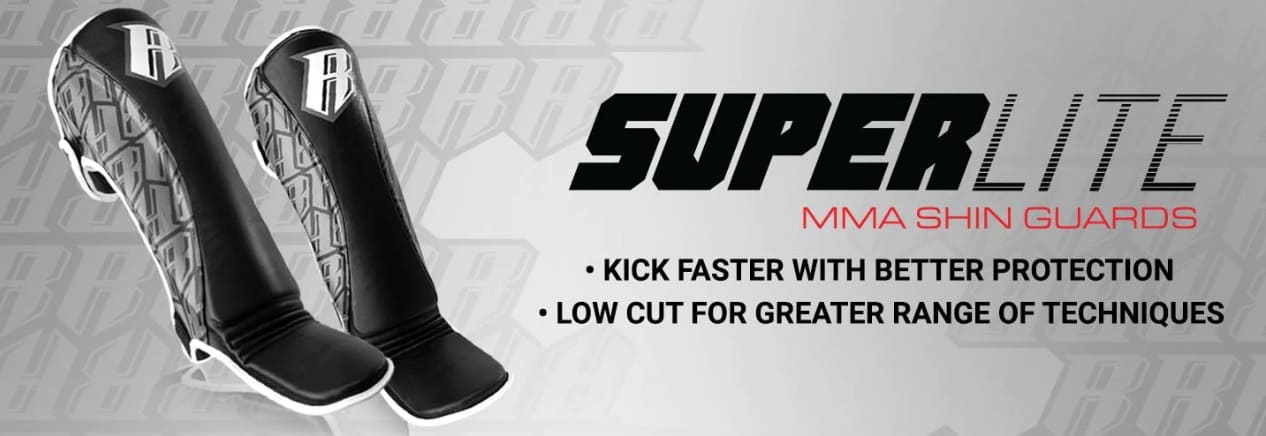 When it comes to choosing the right self-defense style for you, you might find yourself caught up trying to choose between the various styles – there are so many to choose from after all. When trying to choose the style for you, it is important to consider that a few of the fight styles punted as “self-defense” arts are not actually true forms of self-defense at all. And that brings us to the consideration of Krav Maga VS MMA for Self-defense.
When it comes to choosing the right self-defense style for you, you might find yourself caught up trying to choose between the various styles – there are so many to choose from after all. When trying to choose the style for you, it is important to consider that a few of the fight styles punted as “self-defense” arts are not actually true forms of self-defense at all. And that brings us to the consideration of Krav Maga VS MMA for Self-defense.
Krav Maga or MMA for Self Defense?
Krav Maga teaches a person self-defense in a variety of dangerous scenarios including against multiple attackers and weapons, whereas MMA is a sport and trains fighters to fight according to a set of rules against one opponent of similar weight and skill in a ring. This means that MMA training may not particularly help you in a street fight or a surprise attack situation. So, one of the biggest differences between Krav Maga and MMA is that Krav Maga is an actual form of self-defense, whereas MMA is a sport.
Something that a lot of people want to know is “which style of self-defense is better?” and that is not an easy one to answer. It all comes down to your physical capabilities and which style is best suited to your specific needs. The type of training you envision for your life and eventually sign up for will depend on your intended outcomes.
To determine this you will need to ask yourself an important question. It is highly recommended to know the answer with 100% certainty before you sign up for any classes.
The question: do you want to protect yourself in any dangerous confrontation, or do you want to get fighting fit in a controlled, predetermined combat environment? Let’s take a look at the differences between Krav Maga and MMA on various levels, so that you can decide which one is the best fit for you. Read on below.
The Differences Between Krav Maga and MMA
Understanding the differences of Krav Maga VS MMA is the best way to make an informed decision about which fighting style is the right choice for you. Consider the tables below to make the decision easier.
1. The Purpose of Each Style
Krav Maga
The main purpose of Krav Maga is for self-defense, although it is often seen in competition scenarios. Since its conception, Krav Maga teachings were designed to use a combination of simple and practical fighting techniques, such as wrestling, street fighting and boxing, to create a form of fighting that is easy to teach to military forces as well as those seeking a highly-effective form of self-defense. While one can get fit while practicing Krav Maga, its main purpose is simply self-defense.
MMA
The main purpose of MMA is as a combative sport. Competitors must try to get dominance over each other by either striking, finishing holds, or control.
MMA is designed as a competitive sport, also for fitness. All fighting is done in a controlled and predetermined environment, which means that neither opponent is ever in any real danger. MMA does not train people to fight for self-defense but rather to show technique and skill mostly for competitions and to enhance fitness.
2. Comparison of History & Backgrounds
Krav Maga
The history of Krav Maga dates back to 1930 when it was founded by Imi Lichtenfeld in Czechoslovakia. It was designed as a form of self-defense for the Jewish community living in Europe during the Second World War. Lichtenfeld was an expert fighter with experience in both wrestling and boxing.
Lichtenfeld combined the skills taught to him by his father (who was a defense trainer for the local police at the time) with various other fighting techniques in order to form a powerful form of self-defense to be used by the Jews and others faced with aggressive confrontations. To this day, Krav Maga is used for Israeli defense training.
MMA
The history of MMA can be traced back to the Greek Olympics (648BC). At that time it was called Pankration (meaning “all powers” in Greek) and was more a hand-to-hand combat. Pankration had two rules that opponents had to regard: no eye-gouging and no biting – both of these rules still apply today.
Greek athletes recruited as soldiers took the sport to India when fighting for Alexandra the Great. Here is where a Buddhist monk traveling through India encountered it and took knowledge of it to China. In China, the sport became more what we know MMA to be today by incorporating elements of various Asian martial art forms such as kung fu, karate, and judo.
3. Difference in Rules
Krav Maga
The main rule of Krav Maga is to survive. While training at a school, there will be various class rules to adhere to, but these generally pertain to class etiquette.
The reason Krav Maga has no real rules is that opponents are taught to fight unfairly. It is the only way to overcome an opponent who would otherwise fight unfairly with you.
While there are no actual rules in Krav Maga, students are taught to attack and defend in a manner that causes the most amount of pain. In fact, the practice places a great deal of emphasis on head-butting, groin striking and other aggressive attacks.
MMA
MMA has a long list of don’ts that practitioners must adhere to. MMA forbids a variety of moves and holds such as groin strikes and fish hooking.
As part of the rules, MMA fighters cannot:
- Hold onto the cage or opponent
- Head-butt, bite, spit, or hair pull
- Attack opponents outside of fight time
- Bend opponents fingers backward
- Pinch or twist an opponent’s skin
- Eye gouge or claw
- Downward elbow strike, head strike, spine strike, or throat strike
- Heel kick the kidneys
- Use abusive language
- Throw an opponent outside the ring
4. Style and Fighting Techniques
Krav Maga
Krav Maga techniques are based on a few guiding principles as follows:
- Deal with the immediate threat
- Avoid injury
- Transition between defending and attacking seamlessly
- Use natural reflexes in your favor
- Attack and strike vulnerable areas
- Make use of surroundings and close-by objects to gain the upper hand.
The techniques put to use draw inspiration from the likes of boxing, judo, wrestling, Savate, Muay Thai, and several other martial arts.
The techniques and styles follow the basic principles of other martial arts for:
- Groundwork which is derived from judo and wrestling techniques.
- Striking which is derived from boxing and karate.
- Throwing and taking an opponent down which is derived from judo, wrestling, and aikido.
Krav Maga students are taught to eliminate or neutralize the threat before ensuring that the attacker cannot carry out a second attack. The main objective is to end the attack or overcome the attacker as quickly as possible at almost any cost.
MMA
The basic Mixed Martial Arts fighting techniques include the following:
- Striking using hands, legs, elbows and knees. Types of strike styles include: jab, cross, hook, uppercut, elbow strike, knee strike, rear-leg push kick, and round kick body. Striking is based on the same principles of Muay Thai, Boxing, and Kickboxing.
- Clinching, which is derived from judo and wrestling. Types of clinching include: Muay Thai plum, Wrestler’s tie up, Pummel clinch.
- Take-downs, which are based on wrestling techniques. Types of take-downs: Double-leg take-down, and Leg-trip take-down.
- Grappling. Types of grappling include: Offense strikes using fists, Offense strikes using elbow, Defense using fists, and Defense using elbow.
- Submission holds based on wrestling techniques. Submission holds types include: Rear naked choke, Triangle choke, Kimura, and Straight arm bar.
You might find in MMA training that different styles and techniques are taught with different names attached. It all really depends on the school and the instructor. MMA techniques are set and practitioners are required to follow techniques to the letter.
5. Use of Limbs (Kick, Punch, Grapple, Eye Gouge)
Krav Maga
Krav Maga makes use of the whole body. As a high-energy combat style, fighters are on their feet and making use of the whole body.
A student is taught to fight using all limbs to kick, punch, grapple, and eye-gouge as required. Hands, elbows, knees and legs are used for strikes with a combination of kicks and punches.
MMA
Which limbs are used for what in MMA fighting? Here is a brief look at what you can expect:
- Hands – these are the weakest “tool” of a striker in a fight. The hands are used for striking (punching mostly), while gloved.
- Elbows – also used for striking.
- Knees – used primarily for striking.
- Legs – the most powerful “tool” of an MMA fighter used for striking and kicking.
6. As A Sport
Krav Maga
Krav Maga is not a sport although it will get you fit. It is a form of aggressive self-defense based on little to no rules. There is no real competition for Krav Maga. Students of Krav Maga are taught to be ready for whatever comes their way. This means that as a student of Krav Maga you will learn to fight one or multiple attackers, handle unfair fights, and even attack opponents who are potentially heavier or bigger than you.
MMA
MMA is a fighting sport that is competitive too. Students of MMA must learn the rules and techniques and carry them out strictly. Fighters only spar with opponents in the same weight category with similar skills in the sport. Fighting is fair and only one-on-one scenarios. As a student of MMA, you will not be taught how to fight multiple attackers or handle a dirty fight. This means that MMA is merely a sport and of no use in a street fight or surprise attack.
7. Difference in Fighting Protective Gear (Price and Type)
Krav Maga
As Krav Maga is an aggressive form of self-defense, students are taught to practice using full force. Pads are generally used to protect opponents from strikes and impacts (students work in pairs). When training Krav Maga you will also need a few additional pieces of protective gear such as (approx. average Amazon & Revgear prices)
- Sparring pads and punching mitts ($23.50)
- Mouth Guard ($20)
- Headgear ($52)
- Groin Guard ($40)
- MMA Gloves ($21 – $45)
- Boxing Gloves ($30)
- Shin Guards ($24 – $54)
- MMA Footwear ($15 – $183)
Check out all Krav Maga gear Here >>
MMA
MMA requires students and experienced fighters to wear several items of protective gear. The gear is designed to protect opponents from potential injury while sparring. You will need the following items of protective gear (approx. Amazon & Revgear prices):
- MMA Gloves ($21 – $40)
- Shorts ($28)
- Mouth Guards ($12 – $20)
- Shin Guards ($24 – $60)
- Groin Guards ($40)
- Hand Wraps ($6 – $20)
- Head Gear ($34 – $52)
- Ankle Supports ($9 – $18)
Check out all MMA gear Here >>

8. Difference in Price/Cost of Classes
Krav Maga
Many people think that Krav Maga is expensive, but in reality it will cost you less than learning a sport such as MMA. Krav Maga is a short course that is quite intensive. If students attend set classes they can receive an instructor’s certificate in less than 12 months.
Most Krav Maga schools offer the first lesson free but thereafter monthly fees range from around $150 to $250, depending on the area and the school.
MMA
It is difficult to say how long it takes to learn MMA and how many lessons you will need as everyone is different. In general, it takes most students 4 years to learn MMA if they practice for 3 hours a day, 3 days per week.
In most areas classes range from $40 to $45 per hour. Some students like to hire a martial arts instructor and that can cost anything between $30 and $50 per lesson depending on the area.
9. Difference in Classes (Clothes, Routine, What to Expect)
Krav Maga
Clothing:
In Krav Maga, students must wear comfy clothes for practice. Clothing items include yoga pants, gym shorts and loose-fitting t-shirts. There is no set uniform for Krav Maga, but some believe that the traditional gear for it is the Israeli Army’s combat uniform.
Routine:
All Krav Maga classes are different depending on the skill level of the group. Classes are focused on learning how to combine simple martial arts techniques with street fighting techniques. Students are taught to fight dirty and how to handle real-life safety and confrontation threats.
MMA
Clothing:
In MMA classes, students must also wear comfortable clothes for practice. Clothing items include MMA shorts or board shorts, a fitted t-shirt and a rash guard. Students are encouraged to wear a mouthguard and groin guard too. While students are encouraged to have their own gloves and shin pads, sometimes schools provide these.
Routine:
MMA classes are structured according to the current level of skills of the students. Students are taught strict techniques and rules according to a schedule and are expected to practice at home between classes.
10. Time to Learn/Master
Krav Maga
It takes less than a year to complete a Krav Maga training course and be considered competent in the self-defense techniques.
MMA
It takes a student around 4 years to learn the techniques of MMA and be considered competent in the sport.
11. Extreme Learning Conditions
Krav Maga
In Krav Maga classes students are taught to fight aggressively and effectively in all kinds of dangerous scenarios. Students are not just taught to fight one opponent, but multiple people at the same time. Students also learn to fight with one arm or one leg in the event of an injury or disability. They are also taught how to fight blind. This is to ensure that students can in fact protect themselves when faced with life-threatening situations and confrontations.
MMA
MMA classes are not designed to teach students self-defense. Instead, students are taught to fight just one opponent in a controlled fight with a set of rules.
MMA students do not learn how to protect themselves in a street fight and will not be taught how to fight blind or with a serious debilitating injury or disability.
In order to use MMA skills, students must adhere to the rules and fight fair. If there is a serious injury, the fight will be stopped.
12. Levels of Belts and Qualifications
Krav Maga
Krav Maga has several levels that students must typically progress through within 12 months if they wish to reach instructor’s status. Students learning for self-defense reasons can take longer to complete the course if required. The belts in Krav Maga include:
- Level 1: White Belt (Beginner)
- Level 2: Yellow Belt (4 months to achieve)
- Level 3: Orange Belt (6 months to achieve)
- Level 4: Green Belt (9 months to achieve)
- Level 5: Blue Belt (9 months to achieve)
- Level 6: Brown Belt (12 months to achieve)
- Expert Level: Black Belt.
Individuals can test for Black Belt by invitation only. Candidates who reach and test successfully for Brown Belt in less than 12 months are considered for Black Belt testing.
MMA
Newbies to MMA often get confused by the Belt system offered by their school. MMA has no official belt system although some schools offer their own belt system to keep students motivated. In general, MMA students fall into one of two categories: Professionals and Amateurs. When in competition, opponents are matched up according to various weight categories and experience levels. Weight categories are:
- Flyweight (125 lbs max)
- Heavyweight (206 to 265 lbs)
- Strawweight (Women’s category)
Students will usually learn with students who have the same skill level and experience in MMA. For competitions, opponents are paired in much the same way.
13. Ability to Learn By Yourself at Home
Krav Maga
While it might prove difficult to advance without practice and instruction, students can start to learn Krav Maga at home. There are various online tutorials and instructional DVDs that can assist. Learning at home can be beneficial for learning the correct stances, basic techniques and best practices, but to get real practical experience and the chance to learn to actually fight a real person, classes are essential.
MMA
It is not entirely possible to learn MMA alone at home. You can get a basic understanding of the sport on your own, but essentially it is a sport that requires sparring and lots of practice between two people. MMA requires strict care for learning correct techniques and what is allowed/not allowed. While there are several online resources that share MMA inspired workouts, it is essential for students to attend classes.
14. Use of Weapons
Krav Maga
Krav Maga involves an intensive focus on self-defense using weapons. Krav Maga is based on self-defense training that fully prepares the student to defend an attack that may or may not involve any number or kind of weapons. While a student’s hands and legs are their most effective weapon, they never know when an attacker might introduce a real weapon to the situation.
Students of Krav Maga are taught to use weapons in a variety of ways. Training focuses on handling the following weapons:
- Handguns and long guns
- Knives
- Improvised weapons such as cutlery, broken bottles, or anything that is nearby.
MMA
No actual weapons are used during MMA training. As MMA is a sport and not a form of self-defense, students are not taught to fight with weapons or defend themselves in a weapon fight.
15. For Survival
Krav Maga
Krav Maga is a form of self-defense and designed to help students protect themselves. The main rule of Krav Maga is to survive.
MMA
MMA is not a form of self-defense and is therefore not recommended for students looking for a fighting style that aims to promote survival.
16. Difference in Extent of Likely Injuries
Krav Maga
While students are taught aggressive techniques, classes are not aimed at getting opponents to actually hurt each other. That being said, there are common Krav Maga injuries to be aware of:
- Abrasions
- Contusions
- Fractures
- Head injuries
- Neck injuries
- Chest pains
- Sprains
- Bruising
MMA
MMA classes are not focused on opponents injuring each other, but in a competition, fighters may suffer several injuries. Training can also result in injury. The common MMA injuries to be aware of include:
- Lacerations
- Dental injuries
- Hematomas
- Nose fractures
- Blowout fractures
- Concussions
- Bruising
- Broken bones
17. Awareness/Mentality
Krav Maga
Krav Maga is not particularly demanding in terms of lifestyle although students are required to remain generally fit and healthy. The training itself teaches students to be more aware of their surroundings at all times, so that they can easily recognize potential danger and act quickly. Training will develop a student physically, but will also provide improved mental strength, boost self-confidence and develop a survivor’s mindset.
MMA
MMA training requires a certain mindset. Students have to take on a particular way of life that demands hard work, dedication and general healthy living. Practice takes hours, days, and years and can be taxing emotionally, mentally, and physically.
MMA students have to keep pushing themselves harder and constantly aim for self-betterment over many years. MMA is not a hobby; it is a lifestyle that is quite demanding on its practitioners.
18. For Fitness and Strength Training
Krav Maga
Krav Maga is an excellent way to improve fitness and muscle tone, both of which increase strength and stamina. Krav Maga students often look lean, well-toned and strong as a result.
MMA
While MMA training definitely increases fitness levels, it is more known for its ability to greatly increase strength and stamina. MMA fighters are not just toned but actually gain muscle size and strength.
19. Weight Loss
Krav Maga
Because Krav Maga is a high-energy self-defense workout, students can use it for effective weight loss. Extreme weight loss is possible as students can burn between 590 and 931 calories in a class.
MMA
MMA is extremely good for weight loss. In fact, it is known to provide rapid weight loss. MMA fighters burn approximately 590 calories in a 45-minute striking class.
20. Self-Defense
Krav Maga
Krav Maga is a true form of self-defense. It is designed to help individuals protect themselves in dangerous attacks. Krav Maga can protect someone from a rape, street fight, mugging, car-jacking and more.
MMA
MMA is not a form of self-defense. It is a sport. It is therefore not designed to help teach students how to defend themselves in a street fight, mugging, rape attempt or similar.
21. Which is Better Overall?
Which style of fighting is better, is up to the student to decide. Both MMA and Krav Maga are exceptional forms of fighting. Which one is best for you, will depend on your specific needs and interests.
Krav Maga
Krav Maga is best designed for people looking to learn a high energy form of self-defense that boosts fitness and physical strength at the same time.
MMA
MMA is designed for fighters who want to fight an opponent in a competitive sports environment. If students are looking to learn a fighting style for self-defense, MMA might not be the best choice.
Conclusion
Krav Maga vs MMA are fairly different forms of fighting even though both include elements of various forms of martial arts for self-defense. While Krav Maga is designed to teach a brutal form of self-defense, MMA is designed to teach a controlled and competitive style of sport fighting. Choose the one that fits your needs and interests best and enjoy!



